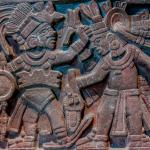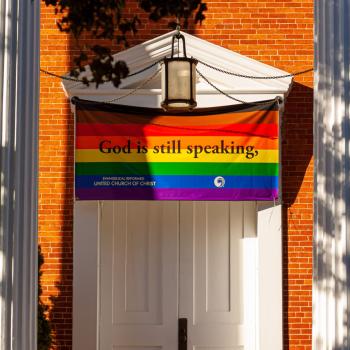In a previous post, I discussed three features of Critical Race Theory that should encourage Christians and non-Christians to resist the use of CRT in various domains of American society. Those features were: 1) Critical Race Theory is not a truth-oriented project, 2) Critical Race Theory is purely and only political, and 3) Critical Race Theory is inherently moralistic. In these next two posts, I will argue that a certain strain of CRT thought, represented here by critical legal scholar Kenneth Nunn, could return us to a system of governance and jurisprudence grounded in polytheistic beliefs and practices were it to take hold in the culture. In other words, we could see a return to the old gods.
To do this, I will first show how this version of CRT attempts to divest American culture, specifically the American legal system, of features of European culture that matter to human flourishing and coincide with a Christian worldview. Then I will show how CRT opens the door for a return to pre-Colonial and pre-Christian forms of law and governance. Of course these two ideas should remain separate, as there may well be “pre-Colonial” forms of law or governance that are worth recapturing. However, I would argue there are not any “pre-Christian” forms of law or governance worth returning to.
Kenneth Nunn and Law as a Eurocentric Enterprise
1. The Construction of Social Realities
In his article, “Law as a Eurocentric Enterprise,” legal scholar Kenneth B. Nunn argues that
Law, as understood in European-derived societies, is not universal. It is the creation of a particular set of historical and political realities and of a particular mindset or worldview. Nunn, Eurocentric Enterprise, 324
In other words, law is merely a product of an ever-developing political culture over time. This implies, of course, that law is not a product of a culture or cultures observing and recognizing something universal about the world and human nature and then creating rules or guidelines given that observation and recognition (or possibly revelation).
On Nunn’s view, and most Critical Race theory views, law itself is generated by entirely immanent cultural, historical and political processes. Any concrete law, therefore, is purely political– full stop. And, as social contexts, i.e., “mindsets” change, then so does the Law and so should laws. This is the same as saying there is nothing pre-social or pre-political that grounds the concept “Law,” or concrete laws. There are only mindsets. These mindsets create laws tailored to a culture’s own preferences, tastes or need for control. The “realities” created are social realities, or social facts. However, they are not Reality in the strong, ontological sense. There is nothing extra-mental which is discoverable because it is part of the fabric of the world in which we exist. Technically, there is no way in which things are supposed to be other than the way we want them. From a Christian perspective this is deeply problematic, even if the way we want things to be sometimes coincide with the way they should be.
2. Law As a White Enterprise
For Nunn, however, the very idea that there can be a universally applicable Law is itself considered a product of white, European culture. Therefore, Law is entirely contingent upon the political dominance of that culture in a given nation or bounded society. Change the dominant culture, or eliminate it completely, and you change or eliminate the entire concept of Law. This fundamental change would make it possible to construct a totally new foundation of law. Or, if not new in the historical sense, then at least something totally different. So long as a non-White cultural group constructs the Law, it will not be the Law we have today. In a seminal work on Critical Race Theory, Richard Delgado and Jean Stefancic put it this way:
The critical race theory (CRT) movement is a collection of activists and scholars interested in studying and transforming the relationship among race, racism, and power. The movement considers many of the same issues that conventional civil rights and ethnic studies discourses take up, but places them in a broader perspective that includes economics, history, context, group- and self-interest, and even feelings and the unconscious.
Unlike traditional civil rights, which stresses incrementalism and step-by-step progress, critical race theory questions the very foundations of the liberal order, including equality theory, legal reasoning, Enlightenment rationalism, and neutral principles of constitutional law.
Richard Delgado and Jean Stefancic, and Angela Harris, “Introduction” In Critical Race Theory: An Introduction, Second Edition. [emphasis added]
Calling into question this much “broader perspective” that civil rights leaders like Martin Luther King Jr. accepted, scholars like Nunn and Delgado highlight what I will call “cognitive features” of white, European culture. These features apparently permeate our sense of the Law and Government and threaten human liberation. According to Nunn, these features or attributes are not only derived from a purely Eurocentric culture, but, it is asserted, that same European culture viewed itself as superior to all other cultures it encountered. This latter claim is not without merit. Every sane person acknowledges the rise of modern racist ideologies in Europe around the late 15th and early 16th century. These racial hierarchy theories were used to justify the African slave trade and unjust treatment of Native Americans. However, that there were dissenting voices in each generation of Europeans, and that that history is more complex than is often presented should not be overlooked.
Still, on Nunn’s view, these cognitive features are not just products of European culture. They are a product of a European “Supremacist” culture. Or, simply put, they derive from a “White Supremacist” culture.
7 Features of Eurocentricity (According to Critical Race Theorists)
The seven features of European culture that are problematic to “our” sense of Law, or governance more generally, are:
- Dichotomous reasoning, or “either/or thinking”
- Employment of Hierarchies
- Analytic Thought
- Objectification
- Abstraction
- Extreme Rationalism
- Descaralization
While space will not allow an in-depth description of each of these attributes, there are some things to point out generally about the list. First, it is simplistic and reductionistic in stating that these are features of only European culture or of all European cultures. Nunn realizes this fairly quickly and so he is forced to qualify his statement:
They [the attributes] do not comprise the totality of European culture, nor are they absent in other cultures. When manifested in a culture that is primarily materialistic, the attributes operate collectively to form a matrix of behavior and belief that is relatively unique. This is not to say that every individual in European culture thinks and acts according to this paradigm, nor is it implying that members of other cultural traditions do not. What is presented here is, by necessity, a generalization.
Nunn, 338
If these generalizations do not compromise the totality of European culture, nor are they absent from other cultures, then we might inquire as to whether this is a fair generalization at all? To what degree or extent these features are or are not a part of white, European culture will matter to Nunn’s thesis. Moreover, where we have seen white, European culture offer alternatives to these attributes from within its own cultural “matrix” will matter too. In addition, to what extent one finds these attributes in other, non-White, non-European cultures will be important. Finally, who has the right or ability to judge these attributes or their combined “matrix” as either positive or negative with regard to building a framework for law, let alone science, technology or medicine, is also crucial to determining whether the conclusions drawn are warranted. In sum, perhaps trying to attribute incredibly broad and vague categories to an entire continent and its manifold sub-cultures is not a profitable undertaking to begin with. Perhaps it is a fool’s errand from the very start.
What Are Some of these Racist Features?
The Racist Act of Abstraction
But, Nunn is committed. He asserts that attributes like the capacity for abstraction become nothing more than a tool of control in European culture:
Since the abstract is separated from the concrete, its validity cannot be questioned. Thus, abstraction becomes a tool of control.
Nunn, 336
Here we see how CRT is purely political. Nothing, literally nothing, lies outside of the political will of the human person or group. And so today we see claims of math itself, the most abstract of the sciences, being treated as a product of “White Supremacy.” On a CRT view, math becomes a mechanism for keeping minorities or “people of color” in social checkmate. On Nunn’s view it would seem the medieval Arabic cultures that created algebra (al-jabr) or the Ptolemaic astronomers of imperial Egypt would have to be considered “white.” Either that or they weren’t doing real math (a bit hard to believe).
The implication that the mathematicians and metaphysicians of European history were theorizing about reality in order to control and dominant over non-European cultures is, on the face of it, absurd. Luther may have scolded the Scholastics for their theological abstraction and its failure to address concrete soteriological concerns, but this charge by Critical Race Theorists is an anachronistic reading of history at best– if not an explicitly Marxist one. Merely asserting that all human projects born out of European cultures are fundamentally about social and political power is to deny the basic, and universal, human attribute of curiosity–i.e., the simple longing for truth. Finally, it is just not true that the validity of abstract concepts cannot be questioned. Logical coherency and explanatory scope and power have always acted as tests for the validity of abstract ideas and systems, not to mention biblical tests for validity. So on this count Nunn is flat wrong.
Dichotomous Thinking, Analytic Thought and Employing Hierarchies
Similar to “abstraction” are the attributes of dichotomous thinking, objectification and analytic thought that white Europeans have also used to subjugate non-white cultures. Of course, what promotes features like dichotomous thinking and analytic thought, i.e., the breaking down of systems into their parts, is the “employment of hierarchies.” According to Nunn, the first hierarchy employed is in the mind itself. He argues, for example, that one of the core flaws of European culture is the idea that reason should rule over the passions:
Thus reason is considered to be superior to its opposite, emotion, “that is, when ‘reason’ rules ‘passion.’ All reality is described in hierarchical terms; consequently, the Eurocentric mind perceives everything as better or worse than something else. In this way, grounds are established for relationships based on power.
Nunn, 335
First, this a parody of the classical view of the human person, since the passions are not considered “the opposite” of reason. Second, however, that Nunn negatively evaluates the ancient idea that reason should control the passions– because it leads to seeing some things as “better” than others– implies that no one from Plato to Augustine to Aquinas would have a place in a CRT-constructed society. The Marquis de Sade, Jean Genet or Henry Miller, on the other hand, may find favored status among CRT advocates like Nunn. Perhaps thinkers like these are the “white” European exceptions to the hastily generalized rule. But Anselm or C.S. Lewis? Certainly not! Even Isaiah, Israel’s prophet, might have gotten it wrong, when he placed these unfortunate words into the very mouth of God: “Come, let us reason together.” A prophetic word that would seem to imply that God thinks dichotomously, or at least the ancient Israelites thought He did. Or, perhaps the author of John’s Gospel was insufficiently inspired when he chose the term Logos to testify to the divinity of Jesus. On a CRT view, it might have been better for the Apostle to write, “In the beginning was the pathos.” Perhaps Critical Race scholars can amend that egregious apostolic error for us.
Social Structures, Authority and The Will of Man
Nunn does not stop in his negative assessment of these 7 cognitive features. He suggests that because white Europeans have employed hierarchy, i.e., seen some things as “better” and others “worse,” and thought reason should rule the emotions, that this intellectual act of prioritizing is the very vehicle for seeing relations as purely power-based. But this is an incredible leap of logic! To go from saying that one evaluates things as better or worse to saying this is how power dynamics arise, whereby power dynamics are seen in entirely moral terms and considered inherently corrupt, is a non sequitur.
For example, it is far from clear that the simple relationship of the position of CEO to the position of employee is itself a moral relationship. It is not as if the moral dimension or quality lies in the difference in authority and responsibility simpliciter. The differentiation in position has no moral quality at all. The moral quality is in the wills of the individuals who hold those positions, not in the positions themselves. Clearly an employee can manipulate his or her boss, just as children can manipulate their parents (and do all the time). These abuses are regardless of the relational positions of each person or the scope of their responsibilities and authority. Truly, it seems there cannot be any relationship of authority on a CRT view that is not inherently corrupt just in virtue of the abstract, relational dynamic itself. Therefore, we should not be surprised today when we see Government officials open to allowing children to decide things without parental consent that just ten years ago would have been unimaginable!
CRT’s Drive to Eliminate Hierarchy
What Nunn ultimately seems to be arguing is that to understand the world as a “great chain of being,” with something like a divine Person or Principle at the top is the real problem in human culture. This very idea just happens to be a “white” one. This white idea leads to seeing things as “superior” and “inferior,” which then automatically devolves into concrete acts of oppression.
On this CRT view, the atheistic materialist who holds to the epistemic primacy of Reason and value of the scientific method has no place in culture. This goes also for the religious Christian, Muslim, or Jew who holds to the ontological primacy of God and epistemic value of sacred scriptures. They too cannot find quarter in a CRT world. For in their very positing of Something or Someone or some Method that is “superior,” they fall under the condemnation of CRT.
Finally, any person of color who accepts these European-derived cognitive attributes on other grounds, e.g. feeling compelled that they are true or useful, must be anathematized from their natural social group. This is why men of singular brilliance like Ben Carson or Thomas Sowell, or women of tremendous achievement like Condoleezza Rice are often dismissed as sellouts. They have bought into “Whiteness.”
The Proper Use of Our Cognitive Capacities
The problem with Nunn’s assessment is that he makes normative claims over attributes that themselves are entirely neutral and natural to the human person. It is not “abstraction” or “objectification” or “analytic thought” that are the problem. It is the people who employ them out of an ill will. All of these attributes are inherently valuable to all human creatures regardless of culture, if they are used in a moral way. The apostle Paul put it most clearly when he admonished the follower of Christ to use these attributes to “demolish arguments and every high-minded thing that is raised up against the knowledge of God,” (2 Cor 10:4-5) and to do so by “taking every thought captive to the obedience of Christ.” In the West, these attributes have been employed to create a legal system that works by-and-large far better than most other historical models. However, they have also fostered human flourishing as they have been applied in the domains of scientific inquiry, communication, engineering, medicine, and ethics. Unfortunately, Nunn sees this differently,
In this way, Eurocentricity reaches out to delineate and direct everything the Eurocentric society produces, within the realm of art, science, economics and social life.
Nunn, 338
There are other reasons than just these cognitive attributes as to why Nunn rejects Eurocentric thinking–entirely moral reasons. I will deal with those in the next post.
In spite of Nunn’s condemnation of these “Eurocentric” ways of thinking, there is one cognitive feature he mentions that really is problematic to European culture. This feature is specific to Enlightenment European culture, and it has negatively affected the modern world. It is also a problem that every Christian must address and that has lead to an extended public debate between faith and science, philosophy and religion. This is the feature of desacralization.
Desacralization and Disenchantment in The West
In A Secular Age, Charles Taylor, borrowing a term from Max Weber, lays out a fundamental reason why there has been a decline of religious belief in the West. This is the problem of disenchantment. In a disenchanted world the “given” background of all social life is reduced to the life of the mind (see Taylor, A Secular Age, 29-42). The idea that nature or the cosmos is imbued with supernatural forces, spiritual agents or that it is ordered by a personal God is absent from the preconditions for belief in a disenchanted culture.
This reduction of all reality down to matter and a human mind that projects meaning onto that matter seems to be what Nunn is getting at with the term “desacralization.” Here there is common ground between the CRT advocate and the classical theist, but not between the CRT advocate and the modern atheist. It is worth quoting Nunn at length on this point:
Nature objectified and rationalized leads to the illusion of a despiritualized universe. In the Eurocentric world-view there is no room for the operation of sacred forces. Nature is reduced to a mere thing, an object that may be manipulated to suit mankind. This is a perspective that is almost uniquely European. Even where God is allowed in Western philosophies, s/he is banished to a separate spiritual realm where s/he can have no effect on quotidian human affairs.
Nunn, 337
Of course, Nunn is right. This is a fair assessment of the deism and later materialism that followed in the wake of the Enlightenment critique of classical metaphysics, religious epistemology, Church authority and the Bible.
The Response of Natural Theology and Philosophy of Religion
While we may excuse Nunn’s ignorance, since he is not a philosopher, his assessment of white, Western rationality leaves out an entire legacy of European thought. It is a legacy that goes back to Justin Martyr and evolves through Augustine and Boethius, then Anselm and Aquinas. It is carried on by the likes of Molina and Leibniz in the early modern era and more recently bu C.S. Lewis, Alvin Plantinga, Richard Swinburne and William Lane Craig. This Natural Theology, moreover, has not been restricted to defending some abstract “god of the philosophers.” All of these thinkers, and many more, have defended everything from miracles to the historical resurrection of Jesus Christ. In other words, they have argued not just for a divine watchmaker, but for a God who acts in “quotidian human affairs.” Just consider the words of Leibniz, who argued that
God continually produces all that is real in creatures. But I hold that in doing it he also continually produces or conserves in us that energy or activity which according to me constitutes the nature of substance and the source of its modifications.
Gottfried Wilhelm Leibniz, Philosophische Schriften
What part of “God continually producing all that is real in creatures” sounds like a distant god? Space will allow only a brief mention of Richard Swinburne’s defense of the Resurrection or Joseph Butler’s defense of miracles. Here are men who pressed analytic thought into service to demonstrate just how sacred the world actually is. Furthermore, if anything, it has been Christian “fundamentalists,” so often maligned by elite academics, who have been the staunchest defenders of a God who acts in the daily lives of men and women. This is a God who gives visions, appears in dreams, inspires prophetic words, and even performs miracles. And this is not even to mention the long, deep history of Roman Catholic or Protestant mystical theology that goes back the 5th and 6th centuries of Latin European Christendom; a history that speaks volumes about a God who is intimately involved with His creatures personal experiences.
Conclusion: CRT’s Attack on Reason is Not an Attack on Proper Reasoning
Still, Nunn and other CRT scholars do have a point. A very atheistic, scientistic materialism does seem to have won out in the West. It is this product of European Enlightenment materialism that does often seek to manipulate nature for its own purposes. Nevertheless, Protestants and Roman Catholics have fought this unaided and purely instrumental form of reason for centuries. The kind of reasoning that gave us Margaret Sanger and Planned Parenthood or “Human Zoos” has been resisted since Butler in the mid-18th century and Pius X in the early 20th.
Still, with Nunn’s condemnation of the other cognitive features, features that all pertain in one way or another to the rational substructure not just of a given legal system but of any system, to include a system of Christian theology, CRT undermines the very project of natural law or natural theology that might belie materialism and legal positivism. Natural Theology, on a CRT view, must also be viewed as a project of “Whiteness.” And, as an exemplification of “Whiteness,” it too must be judged and found wanting. Anyone accepting CRT should therefore abandon the project of Natural Theology as truly the “white man’s religion.” On CRT the god of the philosophers is dead, even if a some supernatural god or gods still live.
In the next post, I will argue how by maintaining room for a re-sacralization of the world, yet at the expense of reason, Nunn’s CRT makes the way clear for Western society to walk the long road back to the old gods of other ancient cultures.

















